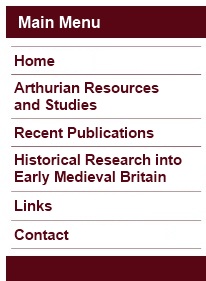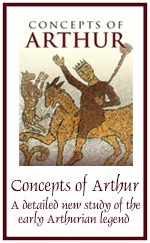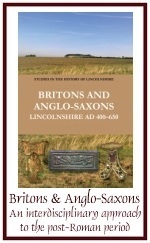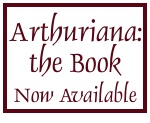
 |
 |
An
Arthurian Reference in Marwnad Gwên?
The Manuscript Evidence Examined
Although the early Welsh poetic references to Arthur are now frequently discussed and utilised, there is one possible reference that is only very rarely mentioned, and only then in non-academic works. This is the apparent reference to Arthur in the Canu Llywarch Hen poem Marwnad Gwên, noted by the Myvyrian Archaiology of Wales, p.93b, and Skene's Four Ancient Books II, p.436. The poem itself has recently been dated by Rowland (in Early Welsh Saga Poetry, pp.388-9) to the late 8th to mid-9th century, and its Arthurian version runs as follows:
The reason for the absence of this reference from recent academic discussions of the early Arthurian legend is the fact that it is not found in the Red Book of Hergest (RB) text of the poem, which is the primary basis of all modern editions. The second line of the englyn in the RB reads:
The version which substitutes arthur for athuc is only noted as a variant reading in the editions of Williams, Ford and Rowland, with no further comment. The question addressed in the present article is simply whether this current rejection of the arthur reading is fully justified. Unfortunately, the Myvyrian Archaiology, which treats the arthur reading as primary, does not reveal its source for this line. Aside from this, the arthur reading is known only from two 'texts' within a single manuscript, National Library of Wales 4973, collected and copied by Dr John Davies of Mallwyd before 1631. The athuc version, on the other hand, is found in the late 14th-century RB, the 1607 Peniarth Ms. 111, BL. Addl. Ms. 31055, and (again) NLW 4973 (the pages from the White Book of Rhydderch (WB) which should have contained this poem are unfortunately missing). The RB is clearly a much older manuscript than any of the others and there are more examples of the athuc reading than the arthur. Nevertheless, it is worth examining these manuscripts further to see whether the arthur version of the englyn can be completely dismissed from consideration. First let us deal with the main athuc readings. The RB is, of course, famous as one of our main sources of medieval Welsh literature. It has been described as a one volume library, containing almost the whole body of Welsh literature known to have been committed to writing before 1400. As such it is easy to see why it has been given priority. However, the RB text cannot be considered to be completely reliable. It should not be forgotten that it is only a late 14th-century copy of a poem which was composed up to 600 years earlier, and editorial work by Williams and others indicates that emendations to the text of the Llywarch Hen englynion are necessary and readings in other manuscripts are sometimes superior. Two of the other athuc readings are related, as both Peniarth Ms. 111 and BL. Addl. Ms. 31055 derive from a lost 1573 copy of the lost WB portions of the Canu Llywarch Hen. As such we can assume that the 14th-century WB version of Marwnad Gwên also read athuc, not arthur . This, naturally, greatly supports the notion that athuc is correct, though not to such a great extent as might be at first thought. The WB is, of course, famous in its own right as the other major repository of medieval Welsh literature aside from the RB, and it is indeed a little earlier in date than the RB (mid-14th century). However, it is not independent of the RB -- they both seem to derive, at least in the case of their englynion poetry, from an earlier common single source (Rowland, 'The Red Book englynion', pp.80-2). As such, the main witnesses to the athuc reading of line 14b of the Canu Llywarch do not in fact represent discrete pieces of evidence for the correctness of this reading; rather they are representative of a single manuscript tradition (although the fact that both the WB and the RB contained athuc indicates that this tradition could well go back beyond the mid-14th century). Next we come to NLW 4973. This manuscript is most interesting, containing copies of a number of different, earlier Welsh manuscripts. Briefly, it includes: a copy of a lost manuscript of the works of the Gogynfeirdd (including 27 poems not found anywhere else); a copy of the Book of Taliesin; the oldest extant copy of Marwnad Cynddylan (a genuinely mid-7th-century poem which includes one of the earliest references to Arthur); a unique version of the 'englynion Llywarch', termed by Rowland 'NLW 4973a' in her study of the englynion poetry; a copy of miscellaneous poetry from the RB; and a second unique copy of the 'englynion Llywarch', termed by Rowland 'NLW 4973b'. From the perspective of Marwnad Gwên, the important thing to note here is that neither 4973a nor 4973b can be seen as a simple composite copy of extant versions. Instead they both appear to be genuinely medieval in origin and independent from the RB and the 'WB' texts (and each other) -- indeed, in some readings they are clearly superior to the RB and the 'WB' and confirm some of the emendations to the text proposed by Williams and others (Rowland, 'Red Book englynion'; Rowland, Early Welsh Saga Poetry, p.397ff.). So how do they treat the second line of the englyn? In fact, both contain both readings of this line. NLW 4973a reads ath hug, changed above to arthur, whilst 4973b reads Arthur, with 'Ll. C [=RB] Athug / ath ddug ' added in the margin. Presumably Davies copied 4973a's athuc reading and then went back, after discovering 4973b's reading, and 'corrected' it to arthur (whilst noting, in 4973b, the fact that RB -- which Davies had available to him -- disagreed with this reading). Thus we effectively have three discrete witnesses to the line in question. One, NLW 4973b, uses arthur and probably goes back to at least the time of the RB, though it is not derived from this. The other two, NLW 4973a and the RB/WB text, use athuc / ath hug, and probably go back beyond the 14th century, though by how much isn't clear. The fact that none of these texts give us a definitive version of the Llywarch Hen englynion, all containing some readings which are superior and some which are inferior to those found in the other manuscripts, means that we cannot be completely certain that the arthur reading of NLW 4973b and Myvyrian Archaiology is a mistake through a consideration of the manuscripts alone. However, the combined 'weight' of the RB, 'WB' and NLW 4973a texts certainly pushes us strongly in this direction, and it is not impossible that whilst NLW 4973a and b do not derive from either the RB or the WB, they could derive from the lost source of the RB/WB text (which would remove the status of the arthur version as a discrete witness to the lost original text and make it simply a mistake in transmission). Can a consideration of context help clear this up any further? Marwnad Gwên is a lament by Llywarch Hen for his son Gwên, who has been killed. If the arthur reading is correct then the englyn in question and the two that follow it would translate as follows:
As should be clear, a reference to Arthur does not really seem to fit here with the context of the piece. The only way we can really accommodate it is if we assume that Gwên is being honoured as a mighty warrior by the poet, either through making Arthur present at his last battle or by calling him Arthur (just as we find Arthur being used in the mid-7th-century Marwnad Cynddylan and the possibly mid to late 9th-century Gereint fil[ius] Erbin). On the other hand, if we choose the athuc reading we run into problems as the text can only be made sense of by emendation. Two such emendations have been proposed. Sir Ifor Williams (Canu Llywarch Hen) suggested that the line should read cat gaduc nu techas rather than the athuc [/ath hug] ny techas we find in all the manuscripts which contain the athuc reading, giving:
Whilst arguably giving better sense than the arthur version, the requirement of serious emendation is troubling because it posits that the RB/'WB'/4973a texts are all corrupted, when it is on the basis of the 'weight' of these texts that the arthur reading (which requires no emendation) is dismissed. The other proposed emendation (by both Caerwyn Williams, BBCS, 21 (1964), pp.26-7, and Rowland, Early Welsh Saga Poetry) is far more elegant and satisfactory, adding only yr to the beginning of the line as it appears in the RB, giving:
Whilst it does still assume that the RB/'WB'/4973a text is corrupt (though to a lesser degree), it provides an explanation of this corruption via the fact that the word preceding athuc in the manuscripts was neithwyr, which, as it ends in -yr, would have made it easy for scribes to skip across a following yr before athuc. To sum up, it seems highly likely that the reference to Arthur in the Myvyrian Archaiology and NLW 4973b versions of Marwnad Gwên, despite both these texts treating it as primary, is in fact a corruption and not 'genuine'. However, given the nature of the manuscript evidence we cannot be completely certain of this, particularly as the non-Arthurian versions of Marwnad Gwên are all assumed to be themselves corrupt, even if primary, and in need of some degree of emendation to make sense (something which is not true of the Arthurian version). * * * * * Copyright © 2002, 2009 Caitlin R. Green. All Rights Reserved. Originally published under a former nom de plume, T. Green. To cite articles or pages from this website, use a service such as WebCite or alternatively see one of the following style citation guides. Comments and queries via email to Caitlin R. Green. |
   |